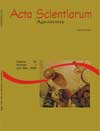<b>Silicate in agricultural production of Peruvian carrot clones</b> - DOI: 10.4025/actasciagron.v31i3.699
Keywords:
Arracacia xanthorrhiza, genotypes, siderurgical waste, yield
Abstract
The production of Peruvian carrot clones was evaluated in response to calcium-magnesium silicate, through an experiment carried out in Viçosa, Minas Gerais State, from May 2004 to March 2005. The experiments were arranged in a complete randomized design, in a 9 x 2 factorial scheme, with the nine clones (Araponga, BGH-4550, BGH-5742, BGH-5744, BGH-5747, BGH-6417, BGH-6425, BGH-6525 and Senador Amaral) cultivated with and without calcium-magnesium silicate (2,500 kg ha-1), with three repetitions. Plants were harvested 304 days post-planting, and the assessed parameters included plant height and diameter, fresh mass of aerial part, commercial roots per plant and yield of commercial and noncommercial roots (rejects), rotten roots and crown, measured in kg ha-1. There was no significant effect of calcium-magnesium silicate application on the yield of commercial roots. Senador Amaral, Araponga, BGH-5747, BGH-5742 and BGH-4550 were the most productive clones, with all having commercial yields above 18,000 kg ha-1. Clone BGH-5744 gave the lowest yield of commercial roots, although it stood out for plant height, diameter and production of fresh mass of aerial part. Further research is recommended to evaluate the effect of calcium-magnesium silicate on the production of Peruvian carrot commercial roots and resistance to diseases.Downloads
Download data is not yet available.
Published
2009-06-23
How to Cite
Sediyama, M. A. N., Santos, M. R., Albanez, A. C. M. P., Ribeiro, J. M. O., Granate, M. J., & Vidigal, S. M. (2009). <b>Silicate in agricultural production of Peruvian carrot clones</b> - DOI: 10.4025/actasciagron.v31i3.699. Acta Scientiarum. Agronomy, 31(3), 427-432. https://doi.org/10.4025/actasciagron.v31i3.699
Issue
Section
Crop Production
DECLARATION OF ORIGINALITY AND COPYRIGHTS
I Declare that current article is original and has not been submitted for publication, in part or in whole, to any other national or international journal.
The copyrights belong exclusively to the authors. Published content is licensed under Creative Commons Attribution 4.0 (CC BY 4.0) guidelines, which allows sharing (copy and distribution of the material in any medium or format) and adaptation (remix, transform, and build upon the material) for any purpose, even commercially, under the terms of attribution.
2.0
2019CiteScore
60th percentile
Powered by 

2.0
2019CiteScore
60th percentile
Powered by 



















































